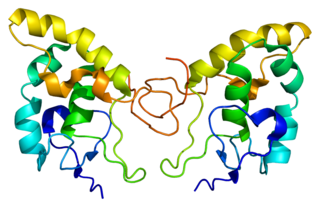The Wnt signaling pathways are a group of signal transduction pathways which begin with proteins that pass signals into a cell through cell surface receptors. The name Wnt is a portmanteau created from the names Wingless and Int-1. Wnt signaling pathways use either nearby cell-cell communication (paracrine) or same-cell communication (autocrine). They are highly evolutionarily conserved in animals, which means they are similar across animal species from fruit flies to humans.

INT-2 proto-oncogene protein also known as FGF-3 is a protein that in humans is encoded by the FGF3 gene.

Frizzled is a family of atypical G protein-coupled receptors that serve as receptors in the Wnt signaling pathway and other signaling pathways. When activated, Frizzled leads to activation of Dishevelled in the cytosol.

Neurogenic locus notch homolog 4(Notch 4) is a protein that in humans is encoded by the NOTCH4 gene located on chromosome 6.

Frizzled-5(Fz-5) is a protein that in humans is encoded by the FZD5 gene.

Frizzled-3(Fz-3) is a protein that in humans is encoded by the FZD3 gene.

Frizzled-1(Fz-1) is a protein that in humans is encoded by the FZD1 gene.

Frizzled-6(Fz-6) is a protein that in humans is encoded by the FZD6 gene.

Frizzled-7(Fd-7) is a protein that in humans is encoded by the FZD7 gene.

Frizzled-8(Fz-8) is a protein that in humans is encoded by the FZD8 gene.

Frizzled-9(Fz-9) is a protein that in humans is encoded by the FZD9 gene. Fz-9 has also been designated as CD349.

Frizzled-4(Fz-4) is a protein that in humans is encoded by the FZD4 gene. Fz-4 has also been designated as CD344.

Secreted frizzled-related protein 1, also known as SFRP1, is a protein which in humans is encoded by the SFRP1 gene.

Protein Wnt-5a is a protein that in humans is encoded by the WNT5A gene.

Low-density lipoprotein receptor-related protein 6 is a protein that in humans is encoded by the LRP6 gene. LRP6 is a key component of the LRP5/LRP6/Frizzled co-receptor group that is involved in canonical Wnt pathway.

Proto-oncogene protein Wnt-3 is a protein that in humans is encoded by the WNT3 gene.

Protein Wnt-10b is a protein that in humans is encoded by the WNT10B gene.

Protein Wnt-2b is a protein that in humans is encoded by the WNT2B gene.

Wingless-type MMTV integration site family, member 2, also known as WNT2, is a human gene.

Ring finger protein 43 is a protein that in humans is encoded by the RNF43 gene.















